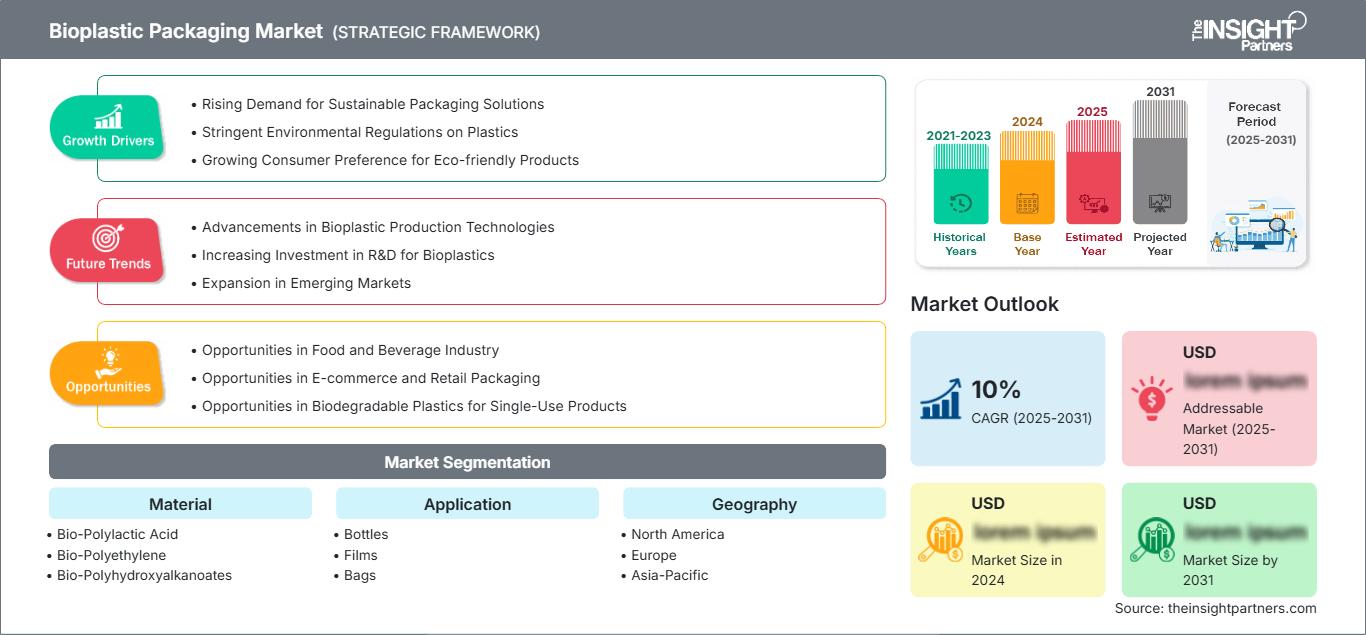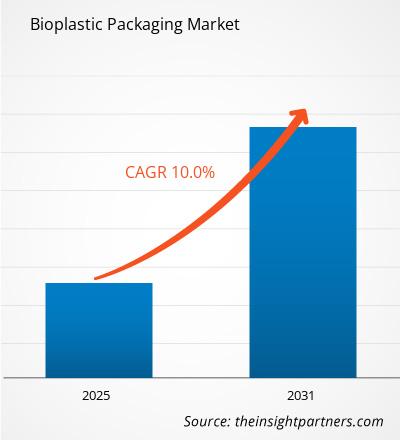Der Markt für Biokunststoffverpackungen wird bis 2031 voraussichtlich ein Volumen von 54,24 Milliarden US-Dollar erreichen. Für den Zeitraum 2025–2031 wird ein jährliches Wachstum von 15,7 % erwartet.
Der Bericht analysiert den Markt nach Material (Bio-Polymilchsäure, Bio-Polyethylen, Bio-Polyhydroxyalkanoate, Bio-Polyethylenterephthalat u. a.) und Anwendung (Flaschen, Folien, Beutel, Sachets, Becher, Schalen u. a.). Zudem werden die Endverwendung (Lebensmittel und Getränke, Kosmetik und Körperpflege, Pharmazeutika und Nahrungsergänzungsmittel, Konsumgüter u. a.) analysiert. Die globale Analyse wird weiter auf regionaler Ebene und für wichtige Länder aufgeschlüsselt. Marktgröße und Prognosen für alle wichtigen Marktsegmente auf globaler, regionaler und Länderebene sind im Bericht enthalten. Die Werte für die Analysen und Segmente werden in US-Dollar angegeben. Der Bericht liefert wichtige Statistiken zum Marktstatus der wichtigsten Marktteilnehmer und bietet Einblicke in Markttrends und -chancen.
Zweck des Berichts
Der Bericht „Markt für Biokunststoffverpackungen“ von The Insight Partners beschreibt die aktuelle Marktlage und das zukünftige Wachstum, die wichtigsten Triebkräfte, Herausforderungen und Chancen. Er bietet Einblicke für verschiedene Akteure im Markt, darunter:
- Technologieanbieter/Hersteller: Um die sich entwickelnde Marktdynamik zu verstehen und potenzielle Wachstumschancen zu erkennen, können sie fundierte strategische Entscheidungen treffen.
- Investoren: Um eine umfassende Trendanalyse hinsichtlich Marktwachstumsrate, Finanzprognosen und Chancen entlang der Wertschöpfungskette durchzuführen.
- Regulierungsbehörden: Um Richtlinien zu regulieren und Aktivitäten auf dem Markt zu überwachen, mit dem Ziel, Missbrauch zu minimieren, das Vertrauen der Investoren zu wahren und die Integrität und Stabilität des Marktes zu gewährleisten.
Marktsegmentierung für biobasierte Verpackungen: Material
- Bio-Polymilchsäure
- Bio-Polyethylen
- Bio-Polyhydroxyalkanoate
- Bio-Polyethylenterephthalat
Anwendung
- Flaschen
- Folien
- Beutel
- Sachets
- Becher und -Schalen
Sie erhalten kostenlos Anpassungen an jedem Bericht, einschließlich Teilen dieses Berichts oder einer Analyse auf Länderebene, eines Excel-Datenpakets sowie tolle Angebote und Rabatte für Start-ups und Universitäten.
Markt für Biokunststoffverpackungen: Strategische Einblicke

-
Holen Sie sich die wichtigsten Markttrends aus diesem Bericht.Dieses KOSTENLOSE Beispiel umfasst Datenanalysen, die von Markttrends bis hin zu Schätzungen und Prognosen reichen.
Wachstumstreiber des Marktes für Biokunststoffverpackungen
- Steigende Nachfrage nach nachhaltigen Verpackungslösungen: Die wachsende Verbrauchernachfrage nach umweltfreundlichen und nachhaltigen Verpackungen ist ein wesentlicher Treiber des Marktes für Biokunststoffverpackungen. Angesichts zunehmender Plastikabfälle und Umweltbedenken bieten Biokunststoffe, die aus nachwachsenden Rohstoffen wie pflanzlichen Materialien hergestellt werden, eine biologisch abbaubare Alternative zu herkömmlichen Kunststoffen. Diese Nachfrage nach nachhaltigen Verpackungslösungen veranlasst die Lebensmittel- und Getränkeindustrie, den Einzelhandel und die Konsumgüterindustrie, Biokunststoffverpackungen einzuführen und so das Marktwachstum anzukurbeln.
- Strenge Umweltauflagen für Kunststoffe: Regierungen weltweit führen strengere Vorschriften zu Plastikmüll, Umweltverschmutzung und nicht biologisch abbaubaren Verpackungen ein, was die Nachfrage nach Biokunststoffen erhöht. Maßnahmen wie Plastikverbote und Programme zur erweiterten Herstellerverantwortung (EPR) ermutigen Hersteller, auf biologisch abbaubare und kompostierbare Alternativen umzusteigen. Biokunststoffe bieten eine praktikable Lösung zur Erfüllung regulatorischer Anforderungen und fördern so das Wachstum des Marktes für Biokunststoffverpackungen, da die Industrie die Einhaltung von Umweltstandards anstrebt.
- Wachsende Verbraucherpräferenz für umweltfreundliche Produkte: Die Verbraucherpräferenzen verlagern sich zunehmend hin zu Produkten mit minimalen Umweltauswirkungen. Verbraucher sind sich des ökologischen Fußabdrucks von Verpackungen immer bewusster und suchen aktiv nach Produkten mit nachhaltigen Verpackungen. Diese wachsende Nachfrage nach umweltbewussten Produkten veranlasst Marken, Biokunststoffverpackungen als Teil ihrer Nachhaltigkeitsbemühungen zu wählen und trägt so zum Gesamtwachstum des Marktes bei.
Zukunftstrends des Marktes für Biokunststoffverpackungen
- Fortschritte bei den Biokunststoff-Produktionstechnologien: Technologische Fortschritte in der Biokunststoffproduktion verbessern die Machbarkeit und Leistungsfähigkeit von Biokunststoffverpackungen. Neue Innovationen in den Verarbeitungstechnologien verbessern die Effizienz und Kosteneffektivität von Biokunststoffen und machen sie wettbewerbsfähiger gegenüber herkömmlichen Kunststoffen. Die Entwicklung neuer biobasierter Polymere wie Polymilchsäure (PLA) und Polyhydroxyalkanoate (PHA) mit verbesserter Haltbarkeit und Funktionalität treibt das Wachstum und die Akzeptanz von Biokunststoffverpackungen in verschiedenen Branchen voran.
- Steigende Investitionen in Forschung und Entwicklung für Biokunststoffe: Investitionen in Forschung und Entwicklung (F&E) eröffnen neue Chancen für den Markt für Biokunststoffverpackungen. Hersteller konzentrieren sich auf die Entwicklung von Biokunststoffen mit verbesserten Eigenschaften wie höherer Festigkeit, Flexibilität sowie Beständigkeit gegenüber Feuchtigkeit und Hitze. Darüber hinaus zielen die F&E-Bemühungen auf die Verwendung nachhaltigerer und lokal gewonnener Rohstoffe für Biokunststoffe ab. Diese Innovationen tragen dazu bei, die Vielseitigkeit des Marktes zu erhöhen und seine Anwendungsbereiche im Verpackungssektor zu erweitern.
- Expansion in Schwellenländern: Schwellenländer in Regionen wie Asien-Pazifik, Lateinamerika und Afrika verzeichnen ein rasantes Wachstum bei der Verwendung von Biokunststoffverpackungen. Das zunehmende Bewusstsein für die Plastikverschmutzung, gepaart mit regulatorischem Druck und staatlichen Anreizen für nachhaltige Verpackungen, ermutigt Unternehmen in diesen Regionen zum Umstieg auf Biokunststoffe. Die steigende Nachfrage nach umweltfreundlichen Verpackungslösungen in Entwicklungsländern schafft erhebliche Wachstumschancen für Hersteller von Biokunststoffverpackungen.
Marktchancen für Biokunststoffverpackungen
- Chancen in der Lebensmittel- und Getränkeindustrie: Die Lebensmittel- und Getränkeindustrie bietet aufgrund ihrer hohen Nachfrage nach Verpackungslösungen erhebliche Chancen für den Markt für Biokunststoffverpackungen. Biokunststoffe sind eine nachhaltige Option für die Verpackung von Lebensmitteln und bieten Vorteile wie biologische Abbaubarkeit und Kompostierbarkeit. Da sich die Verbraucherpräferenzen hin zu nachhaltigeren Verpackungsoptionen verlagern, werden Biokunststoffe in der Lebensmittelverpackung immer beliebter und schaffen Wachstumschancen für Hersteller, die diese Branche bedienen.
- Chancen im E-Commerce und Einzelhandelsverpackungen: Mit dem Aufstieg des E-Commerce steigt die Nachfrage nach nachhaltigen Verpackungslösungen im Online-Handel. Biokunststoffe etablieren sich aufgrund ihrer umweltfreundlichen Eigenschaften als praktikable Option für E-Commerce-Verpackungen. Der verstärkte Fokus auf die Reduzierung von Plastikmüll in Versand- und Verpackungsprozessen ermutigt Einzelhändler, Biokunststoffalternativen einzuführen, wodurch sich lukrative Marktchancen im E-Commerce-Sektor ergeben. Chancen für biologisch abbaubare Kunststoffe bei Einwegprodukten: Der Markt für Alternativen zu Einwegkunststoffen bietet Biokunststoffen erhebliche Chancen. Artikel wie Besteck, Strohhalme und Verpackungsmaterialien gehören zu den häufigsten Einwegkunststoffen und tragen zum Plastikmüll bei. Da Regierungen und Verbraucher Alternativen fordern, bieten Biokunststoffe eine biologisch abbaubare Lösung für diese Produkte. Dieser Wandel hin zu nachhaltigen Verpackungen und Produkten treibt das Wachstum von Biokunststoffen auf dem Markt für Einwegkunststoffe voran.
Markt für Verpackungen aus Biokunststoffen
Die regionalen Trends und Einflussfaktoren auf den Markt für Biokunststoffverpackungen im gesamten Prognosezeitraum wurden von den Analysten von The Insight Partners ausführlich erläutert. Dieser Abschnitt behandelt außerdem die Marktsegmente und die geografische Verteilung des Marktes für das Management von Herzrhythmusstörungen in Nordamerika, Europa, Asien-Pazifik, dem Nahen Osten und Afrika sowie Süd- und Mittelamerika.
Umfang des Marktberichts zu Verpackungen aus Biokunststoffen
By Anwendung- Flaschen
- Folien
- Beutel
- Tüten und Sachets
- Becher und Schalen
- Nordamerika
- Europa
- Asien-Pazifik
- Süd- und Mittelamerika
- Naher Osten und Afrika
- Großbritannien
- Deutschland
- Frankreich
- Russland
- Italien
- Restliches Europa
- China
- Indien
- Japan
- Australien
- Restlicher Asien-Pazifik
- Brasilien
- Argentinien
- Restliches Süd- und Mittelamerika
- Südafrika
- Saudi-Arabien
- Vereinigte Arabische Emirate
- Restlicher Naher Osten und Afrika
Berichtsattribut Einzelheiten Marktgröße in 2024 US$ XX Billion Marktgröße nach 2031 US$ 54.24 Billion Globale CAGR (2025 - 2031) 15.7% Historische Daten 2021-2023 Prognosezeitraum 2025-2031 Abgedeckte Segmente By Material - Bio-Polymilchsäure
- Bio-Polyethylen
- Bio-Polyhydroxyalkanoate
- Bio-Polyethylenterephthalat
Abgedeckte Regionen und Länder Nordamerika - USA
- Kanada
- Mexiko
Marktführer und wichtige Unternehmensprofile - Arkema SA
- Avantium NV
- BASF SE
- Braskem SA
- Eastman Chemical Company
- Futamura Group
- NatureWorks LLC
- Neovia SAS
- Novamont SpA
Dichte der Akteure im Markt für Biokunststoffverpackungen: Auswirkungen auf die Geschäftsdynamik
Der Markt für Biokunststoffverpackungen wächst rasant, angetrieben durch die steigende Nachfrage der Endverbraucher. Gründe hierfür sind unter anderem sich wandelnde Verbraucherpräferenzen, technologische Fortschritte und ein wachsendes Bewusstsein für die Vorteile des Produkts. Mit steigender Nachfrage erweitern Unternehmen ihr Angebot, entwickeln innovative Lösungen, um den Verbraucherbedürfnissen gerecht zu werden, und nutzen neue Trends, was das Marktwachstum zusätzlich beflügelt.

- Holen Sie sich die Markt für Biokunststoffverpackungen Übersicht der wichtigsten Akteure
Wichtigste Verkaufsargumente
- Umfassende Abdeckung: Der Bericht bietet eine umfassende Analyse der Produkte, Dienstleistungen, Typen und Endnutzer des Marktes für Biokunststoffverpackungen und vermittelt so ein ganzheitliches Bild.
- Expertenanalyse: Der Bericht basiert auf dem fundierten Wissen von Branchenexperten und Analysten.
- Aktuelle Informationen: Der Bericht gewährleistet Geschäftsrelevanz durch die Berücksichtigung aktueller Informationen und Datentrends.
- Anpassungsmöglichkeiten: Dieser Bericht kann an spezifische Kundenanforderungen angepasst werden und sich optimal in die Geschäftsstrategien integrieren.
Der Forschungsbericht zum Markt für Biokunststoffverpackungen kann somit maßgeblich dazu beitragen, das Branchenszenario und die Wachstumsaussichten zu entschlüsseln und zu verstehen. Auch wenn einige berechtigte Bedenken bestehen, überwiegen die Vorteile dieses Berichts insgesamt die Nachteile.
- Historische Analyse (2 Jahre), Basisjahr, Prognose (7 Jahre) mit CAGR
- PEST- und SWOT-Analyse
- Marktgröße Wert/Volumen – Global, Regional, Land
- Branchen- und Wettbewerbslandschaft
- Excel-Datensatz
Aktuelle Berichte
Verwandte Berichte
Erfahrungsberichte
Grund zum Kauf
- Fundierte Entscheidungsfindung
- Marktdynamik verstehen
- Wettbewerbsanalyse
- Kundeneinblicke
- Marktprognosen
- Risikominimierung
- Strategische Planung
- Investitionsbegründung
- Identifizierung neuer Märkte
- Verbesserung von Marketingstrategien
- Steigerung der Betriebseffizienz
- Anpassung an regulatorische Trends






















 Kostenlose Probe anfordern für - Markt für Biokunststoffverpackungen
Kostenlose Probe anfordern für - Markt für Biokunststoffverpackungen